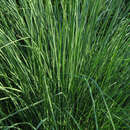Comprehensive Description
(
Anglèis
)
fornì da North American Flora
Muhlenbergia lindheimeri Hitchc. Jour. Wash. Acad. Sci 24: 291. 1934.
Epicampes gracilis Trin. Mem. Acad. St.-Pctersb. VI. 6=: 271. 1841. (The published locality is Mexico, but the type specimen is from eastern Texas, probably collected by Berlandier.) Not Muhlenbergia gracilis (H.B.K.) Kunth.
Perennial; culms erect, slightly scaberulous or glabrous, 1-1.5 m. tall, the basal tuft of sheaths compressed-keeled; sheaths keeled, glabrous or nearly so; ligule rather thin, elongate, mostly hidden in the folded base of the blade ; blades elongate, firm, flat or usually folded, about 3 mm. wide, scaberulous or glabrous; panicle narrow, pale, rather dense, erect, 20-40 cm. long, the axis scabrous, the branches ascending or appressed, 2-5 cm. long; spikelets 2.5-3 mm. long; glumes acute to rather obtuse, scabrous-puberulent to nearly smooth; lemma about as long as the glumes, 3-nerved, glabrous to obscurely pubescent, awnless or rarely with an awn as much as 3 mm. long.
TvPK locality: Eastern Texas (Lindheimer 725). Distribution: Rocky sloi>es, Texas.
- sitassion bibliogràfica
- Albert Spear Hitchcock. 1935. (POALES); POACEAE (pars). North American flora. vol 17(6). New York Botanical Garden, New York, NY
Physical Description
(
Anglèis
)
fornì da USDA PLANTS text
Perennials, Terrestrial, not aquatic, Stems nodes swollen or brittle, Stems erect or ascending, Stems caespitose, tufted, or clustered, Stems terete, round in cross section, or polygonal, Stems compressed, flattened, or sulcate, Stem internodes hollow, Stems with inflorescence less than 1 m tall, Stems with inflorescence 1-2 m tall, Stems, culms, or scapes exceeding basal leaves, Leaves mostly cauline, Leaves conspicuously 2-ranked, distichous, Leaves sheathing at base, Leaf sheath mostly open, or loose, Leaf sheath smooth, glabrous, Leaf sheath or blade keeled, Leaf sheath and blade differentiated, Leaf blades linear, Leaf blades 2-10 mm wide, Leaf blades mostly flat, Leaf blade margins folded, involute, or conduplicate, Leaf blades more or less hairy, Leaf blades scabrous, roughened, or wrinkled, Ligule present, Ligule an unfringed eciliate membrane, Inflorescenc e terminal, Inflorescence a contracted panicle, narrowly paniculate, branches appressed or ascending, Inflorescence a dense slender spike-like panicle or raceme, branches contracted, Inflorescence solitary, with 1 spike, fascicle, glomerule, head, or cluster per stem or culm, Inflorescence spike linear or cylindric, several times longer than wide, Inflorescence branches more than 10 to numerous, Flowers bisexual, Spikelets pedicellate, Spikelets laterally compressed, Spikelet less than 3 mm wide, Spikelets with 1 fertile floret, Spikelets solitary at rachis nodes, Spikelets all alike and fertille, Spikelets bisexual, Spikelets disarticulating above the glumes, glumes persistent, Spikelets disarticulating beneath or between the florets, Rachilla or pedicel glabrous, Glumes present, empty bracts, Glumes 2 clearly present, Glumes equal or subequal, Glumes shorter than adjacent lemma, Glumes 1 nerved, Lemmas thin, chartaceous, hyaline, cartilaginous, or membranous, Lemma simi lar in texture to glumes, Lemma 3 nerved, Lemma glabrous, Lemma apex acute or acuminate, Lemma distinctly awned, more than 2-3 mm, Lemma with 1 awn, Lemma awn less than 1 cm long, Lemma awns straight or curved to base, Lemma margins thin, lying flat, Lemma straight, Callus or base of lemma evidently hairy, Callus hairs shorter than lemma, Palea present, well developed, Palea membranous, hyaline, Palea about equal to lemma, Palea 2 nerved or 2 keeled, Stamens 3, Styles 2-fid, deeply 2-branched, Stigmas 2, Fruit - caryopsis, Caryopsis ellipsoid, longitudinally grooved, hilum long-linear.
Muhlenbergia lindheimeri: Brief Summary
(
Anglèis
)
fornì da wikipedia EN
Muhlenbergia lindheimeri is a species of bunch grass, 3-6' H, known by the common names big muhly, blue muhly, and Lindheimer's muhly. It is native to North America, where it can be found in northern Mexico and up to the Edwards Plateau region of Texas. It is also grown as an ornamental grass. as it is useful as a green screen (instead of Pampass grass), erosion control, water retention and nest material for many species of birds
This species is a perennial grass forming clumps of erect stems up to 1.5 meters tall. The ligule may be up to 3.5 centimeters in length. The leaves are up to 55 centimeters long and are flat or folded. The inflorescence is a panicle up to 50 centimeters long which is often purplish in color, with grayish spikelets.
This grass provides graze for cattle and horses, but it is not one of the more palatable grasses because it is wiry. In the wild the grass grows in calcareous soils.
Ornamental cultivars of this species include 'Autumn Glow'.
- licensa
- cc-by-sa-3.0
- drit d'autor
- Wikipedia authors and editors

